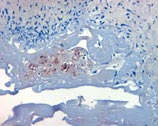Osteoclastic activity and bone resorption seen in Charcot arthropathy
The AOFAS awarded its Leonard J. Goldner award to researchers who studied the etiology of Charcot joint.
Click Here to Manage Email Alerts
![AOFAS Seattle [logo]](/~/media/images/news/print/orthopedics-today/2004/09_september/aofas_180_69_1743.gif) SEATTLE — An
immunohistochemical study into destruction of bone architecture from Charcot
arthropathy in the foot found it was related to enhanced bone resorption and
increased osteoclastic activity. Results suggest it may eventually be possible
to use pharmacologic agents to treat this condition and control its destructive
effects.
SEATTLE — An
immunohistochemical study into destruction of bone architecture from Charcot
arthropathy in the foot found it was related to enhanced bone resorption and
increased osteoclastic activity. Results suggest it may eventually be possible
to use pharmacologic agents to treat this condition and control its destructive
effects.
Charcot arthropathy occurs in up to 5% of patients with diabetes mellitus and peripheral neuropathy, and it can severely affect ambulation and quality of life. “There’s really been limited basic science investigation into Charcot arthropathy,” said Judith F. Baumhauer, MD, department of orthopedics, the University of Rochester in New York.
In one of the first major investigations into the biology of the disease, Baumhauer and researchers from three U.S. centers used Charcot foot surgical specimens to study cell types that were present and any related cytokine mediation. Baumhauer presented results at the American Orthopaedic Foot and Ankle Society 20th Annual Summer Meeting.
Their research was awarded the Leonard J. Goldner Award as the best basic science paper at the meeting.
Cell staining
COURTESY OF JUDITH F. BAUMHAUER |
Researchers used 20 specimens that were fixed in formalin, decalcified, placed in paraffin blocks and sectioned. H&E staining was done with additional immunohistological staining in nine of the specimens for polyclonal antibodies for IL-1, IL-6 and TNF-?. Rheumatoid arthritis antibodies known from previous studies to express the same cytokine mediators were used. Positive controls were inflammatory cells from rheumatoid synovium tissue sections.
Cell types were described and quantified. Two independent investigators used a validated grading scale to classify staining as focal (<10% of cells), moderate (10% to 50%) or diffuse (>50%).
A majority of specimens were from patients (average age 55) with type 2 diabetes and Eichenholz staging grade 2. Most were from men. Five specimens had noninfected ulcers.
“In this qualitative data we noticed that there were a significantly large number of osteoclasts. If you just section regular bone it would be rare to see an osteoclast, and we saw many of them per high-powered field.”
The number of osteoblasts was were also increased, but there were less of them compared to the osteoclasts. “This is consistent with proportional increase in bone resorption,” Baumhauer said.
Under microscopic inspection, the bone specimen matrix was highly disorganized. IL-1 was stained diffuse in two specimens and moderate in seven, which was significant staining for these cytokines, she said.
For IL-6, all were diffuse. For TNF-? eight were moderate and one stained diffusely.
“We saw an increased number of osteoclasts, increased cell mediators for bone resorption — IL-1, IL-6, and TNF-? — which led to increased osteoclast differentiation, proliferation and recruitment. That’s where we need to focus our attack phase.”
These findings support conducting trials into alternative medical management, such as using TNF-? inhibitors, Baumhauer said.
For more information:
- Baumhauer JF, O’Keefe R, Schon LC, Pinzur MS. Free cytokine induced osteoclastic bone resorption in Charcot arthropathy: An immunohistochemical study. Presented at the American Orthopaedic Foot and Ankle Society 20th Annual Summer Meeting. July 29-31, 2004. Seattle.

